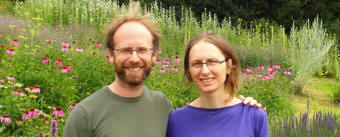|
Previously we have been focusing on medicinal herbs that are easy to grow and common worldwide. This time we would like to write about Lemon Balm and Peppermint. Both plants can easily be grown in garden beds or in pots on a balcony or windowsill, and when grown in a Homa atmosphere they have even greater medicinal properties and aroma. Only the leaves and stems are used medicinally.
Lemon Balm
(Melissa officinalis)
This is a bushy herb growing 40 to 80 cm tall with small white flowers and a strong lemon scent to its green leaves. Seeds can be slow to germinate but once established it grows easily with little attention. Start early under cover or indoors in pots keeping the temperature above 20 °C. Pot up and plant out in spring. Lemon Balm is a full hardy herb that likes most soils and full sun.
You can harvest the whole aerial part of the plant just before it goes to flower and dry carefully and quickly so as to retain as much of the volatile oils as possible. Herbs can be dried in bunches in a dry and well ventilated area out of direct sunlight. Store in airtight containers with a sprinkling of Agnihotra Ash Powder.
Lemon Balm makes a very pleasant tea that is relaxing to the nervous and digestive systems and lowers blood pressure. Drink this tea for digestive cramps and flatulence. As it is calming as well as gently uplifting, Lemon Balm is good for anxiety, insomnia, stress and mild depression.
Lemon Balm is anti-viral so is often included in cold and flu herb mixtures. You can also make a medicinal ghee with the herb that can be used on cold sores, chicken pox, and herpes. We explained how to make medicinal Calendula ghee in one of the previous HHNL editions and you can use the same method with Lemon Balm leaves.
It can help normalize an overactive thyroid and may also regulate an under-active thyroid. |
Trials have shown Lemon Balm increases concentration and memory, which together with its anxiety and stress reducing actions, means it is the ideal herb to take before any exams.
Peppermint (Mentha piperita)
Peppermint grows 30 – 100 cm tall with a square purple stem and green or purple-green leaves. Peppermint is difficult to grow true from seed, so it is best to buy seedlings or propagate by division or as cuttings. Once established it will spread out quickly via its creeping roots and may need to be contained with a barrier. All the mints have medicinal properties but Peppermint is usually considered to have the strongest action. For children and pregnant women, you can use more gentle mints like Spearmint. Harvest aerial parts just before flowers open and dry in the same way as Lemon Balm.
Peppermint is a contradictory herb as it is both stimulating to the circulatory system but relaxing to the nervous system. Peppermint makes a delicious tea and is an excellent remedy for gastro-intestinal disorders such as indigestion and gas. It improves appetite and digestion and relieves nausea, morning sickness and motion sickness. Drinking an infusion eases anxiety, tension, headaches, and relieves painful periods.
For cold and flu, it combines well with Lemon Balm, and Chamomile. Drink Peppermint tea regularly if you are prone to Urinary Tract Infections.
Peppermint is an invaluable aromatic herb often added to tea mixtures for its broad action and aromatic flavour.
To make Lemon Balm or Peppermint tea add 1-2 teaspoons of dried herb and a pinch of Agnihotra ash per cup of boiling water, let it sit for 5-10 minutes and strain. If using fresh herb then use about 3 teaspoons per cup.
Enjoy the tasty tea! |

